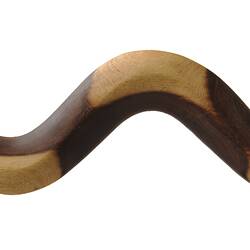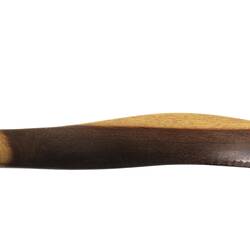Summary
This carving is beautifully made from a piece of mulga wood, the artist skilfully using the dark and light tones of the wood to represent the liru (snake) in motion.
The liru is significant at Yalata. This Pitjantjatjara community descends from the desert people in the north and north-west. The great Rainbow Serpent Wanampi shaped their country - from the red spinifex terrain in the north to the Head of Bight on the South Australian coast.
Wanampi, who resides at the Mutitjulu waterhole at the base of Uluru, journeyed from the red desert country, carving out the rolling hills and subterranean caves as Goanna men from the north chased him from waterholes. The landscape is marked with Wanampi's passage south to the Head of Bight, as he escaped across the Nullarbor Plain. The Goanna men speared the serpent as he was hiding in a rock hole. His blood spilt to form a large red claypan, as he writhed to escape and go underground. Consequently, the Plain is scattered with sites where Wanampi popped out of the ground to see if his attackers were still in pursuit.
Local Name
Liru
Physical Description
Carved wooden snake with a wavy body, pointed tail and small head. The cross-section of the body is triangular while the head is convex in cross section. The snake has two eyes, nostrils and a mouth. The body of the snake is smooth and undecorated although the wood has two tones.
Significance
Regrettably the name of the Pitjantjatjara person who made this liru (snake) was not recorded when it came into the Museum collection. It is known that the artist from the Yalata community, which identifies as southern Anangu (people from the Central and Western Deserts) and speaks a Pitjantjatjara dialect.
These people originally came from the desert in the north and north-west and were removed from their lands in the late 19th century, largely as a result of pastoral leases. They were again forcibly displaced in the 1950s when nuclear tests were conducted on their ancestral lands without their knowledge or permission with devastating and long-lasting effects on both the people and their Country. The families eventually settled on a mission in coastal South Australia. Today, the Anangu live in small communities and outstations across over 103,000 square kilometres of their traditional lands. In the summer, family groups move north to attend ceremonies.
Most recently, Yalata community artists have told their story in relation to the devastating effects of nuclear testing on their Country and peoples through a sculpture which was presented to the Japanese community at Nagasaki, a community who were also catastrophically affected by atomic bombings. Yalata community leader Russell Bryant commented on the powerful connection and friendship experienced as part of this cultural exchange;
'Japan and Yalata people, Maralinga people, they both got same stories'.
Russell Bryant, 2016.
References
ABC News, Maralinga Nuclear Test Survivors Connect with Japanese Bombing Survivors, 2016, Viewed 23 August 2017.
http://www.abc.net.au/news/2016-04-14/australian-japanese-nuclear-survivors-connect-maralinga-nagasaki/732637
More Information
-
Object/Medium
Animal figure
-
Maker
-
Cultural Groups
-
Locality
-
Date Produced
-
Collector
-
Date Collected
-
Object Measurements
840 mm (Length), 130 mm (Width), 30 mm (Height)
-
Classification
-
Date Made
-
Maker
-
Clan/Language Group
-
Place Made
-
Indigenous Region
-
Keywords
-
Collection Names
-
Type of item
-
Discipline
-
Category
-
Collecting Areas



